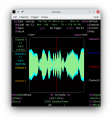Difference between revisions of "Software Oscilloscopes"
From TheAnalogThing
m (Moved text... still chaos) |
(Adding nanoscope) |
||
| (4 intermediate revisions by 2 users not shown) | |||
| Line 1: | Line 1: | ||
| − | + | What follows is a curated list of '''Software oscilloscopes''' (also abbreveated as '''Softscopes'''). While basically any modern digital [[Oscilloscope]] is formally a softscope, we want to discuss here only software running on commodity/consumer level hardware such as on | |
| − | [[ | + | * Desktops and Laptops: Windows/Mac/Linux |
| − | + | * Mobile devices: tablets and smartphones | |
| + | * Embedded: System on chips and microcontrollers, such as [[Raspberry Pi]] and [[Arduino]] | ||
| − | + | For data aquisition, several techniques exist: | |
| − | + | * [[Soundcard Oscilloscope|Soundcard]] input for mono or stereo audio recording | |
| + | * ADCs on boards for analog to digital conversion, typically embedded within microcontrollers | ||
| − | [[ | + | === List of software based oscilloscopes === |
| − | + | <gallery> | |
| + | File:Webscope_Screenshot.png|link=Web Oscilloscope|[[Web Oscilloscope|Browser based oscilloscopes]] | ||
| + | File:Win Softscope 1.png|link=Win Soundcard Oscilloscope|[[Win Soundcard Oscilloscope]] | ||
| + | File:Xoscope_Screenshot.png|link=Xoscope|[[Xoscope]] linux desktop oscilloscope | ||
| + | File:Oscilloppoi1.png|link=Oscilloppoi|[[Oscilloppoi]] Mac OS X desktop oscilloscope | ||
| + | File:nanoscope.png|link=Nanoscope|[[Nanoscope]] open-source Linux/Mac/Win Python-based desktop oscilloscope | ||
| + | </gallery> | ||
| − | + | == Data aquisition tools == | |
| − | |||
| − | |||
| − | |||
| − | |||
| − | |||
| − | |||
| − | |||
| − | |||
| − | |||
| − | |||
| − | |||
| − | |||
| − | |||
| − | |||
| − | |||
| − | |||
| − | |||
| − | |||
| − | |||
| − | |||
| − | |||
| − | |||
| − | |||
| − | |||
| − | |||
| − | |||
| − | |||
| − | |||
| − | |||
| − | |||
| − | |||
| − | |||
| − | |||
| − | |||
| − | |||
| − | |||
| − | |||
| − | |||
| − | |||
| − | |||
We will soon report additional solutions and projects for data aquisition based on barebone microcontroller boards with ADC shields to digitize the analog signals. | We will soon report additional solutions and projects for data aquisition based on barebone microcontroller boards with ADC shields to digitize the analog signals. | ||
| − | + | Microcontroller/System on Chip based input: | |
* [[Arduino]] for data aquisition | * [[Arduino]] for data aquisition | ||
* [[Teensy]] for data aquisition | * [[Teensy]] for data aquisition | ||
* [[Raspberry]] | * [[Raspberry]] | ||
| + | |||
[[Category:Software]] | [[Category:Software]] | ||
Latest revision as of 19:16, 31 May 2022
What follows is a curated list of Software oscilloscopes (also abbreveated as Softscopes). While basically any modern digital Oscilloscope is formally a softscope, we want to discuss here only software running on commodity/consumer level hardware such as on
- Desktops and Laptops: Windows/Mac/Linux
- Mobile devices: tablets and smartphones
- Embedded: System on chips and microcontrollers, such as Raspberry Pi and Arduino
For data aquisition, several techniques exist:
- Soundcard input for mono or stereo audio recording
- ADCs on boards for analog to digital conversion, typically embedded within microcontrollers
List of software based oscilloscopes
Xoscope linux desktop oscilloscope
Oscilloppoi Mac OS X desktop oscilloscope
Nanoscope open-source Linux/Mac/Win Python-based desktop oscilloscope
Data aquisition tools
We will soon report additional solutions and projects for data aquisition based on barebone microcontroller boards with ADC shields to digitize the analog signals.
Microcontroller/System on Chip based input:




